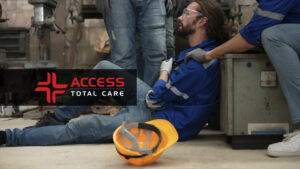Immediate care centers can provide valuable timely medical attention and X-ray diagnostics for non-life-threatening conditions. Walk-in clinics continue to grow in popularity due to their ability to deliver quick and accurate diagnoses.
The X-ray machine is one of the most valuable diagnostic tools at immediate care clinics. However, when you head to urgent care, and they suggest x-rays, you might quickly say no or question why. Knowing why they’re important in an urgent care setting can help you if you’re ever in this situation.
The Importance of Urgent Cares
Urgent care centers bridge the gap between primary care physicians and emergency rooms. Moreover, they offer a convenient option for patients needing prompt medical attention without the extended wait times often associated with emergency departments.
Conditions treated at immediate care centers range from minor injuries and fractures to infections and acute illnesses. Overall, the goal is to provide high-quality, immediate care, ensuring patients receive the appropriate treatment quickly and efficiently.
History of X-rays in Immediate Care Centers
The integration of X-ray technology into immediate care centers is relatively recent. The development of technology dates back to 1895 when it was so large and complex. Their size made them only available in hospital settings, and the expertise needed to operate them.
Advances in the late 20th century made machines more compact, user-friendly, and portable. The timing of more compact X-ray machines and the emergence of urgent care and walk-in clinics couldn’t have been better. Walk-in clinics providing immediate care for non-emergent issues to people became a huge part of our healthcare model.
As immediate care centers became more popular, the inclusion of X-ray machines was a no-brainer. It’s not an intricate part of the urgent care process and helps keep emergency rooms available for emergencies.
X-Rays are a Diagnostic Tool
X-rays, a form of electromagnetic radiation, are indispensable in medical imaging. They allow healthcare providers to view the inside of the body, making them essential for diagnosing various conditions. In urgent care settings, X-rays are particularly valuable for evaluating injuries and illnesses that require immediate attention.
Broken Bones
One of the most common uses of X-rays in urgent care is diagnosing broken bones. Patients with symptoms such as severe pain, swelling, and the inability to move a limb are prime candidates for X-ray imaging.
Health professionals in urgent care can use X-rays to identify a fracture quickly. This enables them to administer the proper treatments, casts, and referrals to orthopedic doctors.
Joint Dislocations
Joint dislocations are another condition frequently encountered in urgent care settings. X-rays help determine the extent of the dislocation and guide the healthcare provider in performing a safe and effective reduction, putting the joint back in place.
Getting an X-ray of the joint can allow the center’s providers to offer pain medication and help move the joint back into place, getting you feeling better faster.
Respiratory Conditions
X-rays are not limited to musculoskeletal issues. They are also vital for diagnosing respiratory conditions. For instance, a patient presenting with severe cough, shortness of breath, or chest pain might undergo a chest X-ray.
This imaging can reveal conditions like pneumonia, bronchitis, or other lung pathologies, enabling the urgent care provider to swiftly prescribe appropriate treatments or antibiotics.
Enhancing Patient Outcomes with Immediate Care
Thanks to X-rays, quick diagnosis directly contributes to better patient outcomes. Early detection and treatment of medical conditions can significantly reduce recovery times and prevent complications.
For example, identifying a fracture immediately after an injury ensures the bone is properly aligned and immobilized, reducing the risk of improper healing or long-term mobility issues.
In the case of respiratory conditions, a timely X-ray can distinguish between different types of infections, ensuring that the patient receives the correct medication. This precise approach reduces the likelihood of complications, such as the spread of infection or the development of chronic respiratory issues.
Streamlining the Treatment Process
Immediate care centers thrive on efficiency. The ability to perform X-rays on-site streamlines the entire treatment process. Patients receive a one-stop experience, eliminating the need for additional appointments or referrals to imaging centers. This convenience is particularly beneficial in urgent care, where the objective is to provide immediate care.
For instance, a patient with a suspected fracture can walk into a clinic, get an X-ray, receive a diagnosis, and treat their injury in a single visit. This streamlined approach saves time and reduces the stress and inconvenience associated with multiple healthcare visits.
The Convenience of Immediate Care
For many patients, receiving X-rays at an immediate care center is convenient. Walk-in clinics accommodate patients without prior appointments, making healthcare accessible and convenient. This accessibility is particularly important for individuals with busy schedules or requiring urgent attention outside of regular office hours.
Having X-ray capabilities on-site means patients can receive comprehensive care in one location. This reduces the need for additional appointments and minimizes disruptions to their daily lives. This convenience is a significant advantage for parents with young children, professionals with demanding jobs, or anyone with a tight schedule.
Advanced Technology and Training
The effectiveness of X-rays in urgent care diagnosis also depends on the technology used and the training of healthcare providers. Modern urgent care centers invest in advanced imaging equipment that provides high-quality images with lower radiation exposure. Digital X-rays, for example, offer clearer images and faster processing times compared to traditional film X-rays.
Moreover, the staff at urgent care centers can operate X-ray machines and interpret the results accurately.
Radiologic technologists, in particular, play a crucial role in ensuring that X-rays are safe and effective. Their expertise, combined with the advanced technology available, ensures patients receive accurate diagnoses and appropriate care.
Safety Considerations at Immediate Care
While X-rays are a powerful diagnostic tool, there are safety considerations to think about. Using X-rays involves exposure to ionizing radiation. In small doses, it’s not an issue but with a larger dose, it can cause health issues.
However, the amount of radiation used in medical X-rays is generally low and considered safe for diagnostic purposes. Urgent care centers adhere to strict safety protocols to minimize radiation exposure and protect patients.
Healthcare providers assess the necessity of X-rays on a case-by-case basis, considering the potential benefits and risks. By using the lowest effective dose of radiation and shielding vulnerable areas, urgent care centers maintain a high standard of patient safety.
X-rays are Invaluable in Urgent Cares
X-rays are an indispensable component of urgent care diagnosis, offering rapid and accurate assessments of various conditions. From fractures and joint dislocations to respiratory illnesses, the ability to perform on-site X-rays enhances the immediate care walk-in clinics provide.
This convenience, combined with advanced technology and skilled healthcare professionals, ensures patients receive timely and effective treatment.
As urgent care centers continue to evolve, integrating diagnostic tools like X-rays will remain crucial. By prioritizing prompt and accurate diagnosis, these centers not only improve patient outcomes but also reinforce their role as vital resources in the healthcare landscape.
Whether it’s a minor injury or a more serious condition, the availability of X-rays in urgent care centers ensures that patients receive the immediate care they need when they need it most.




















